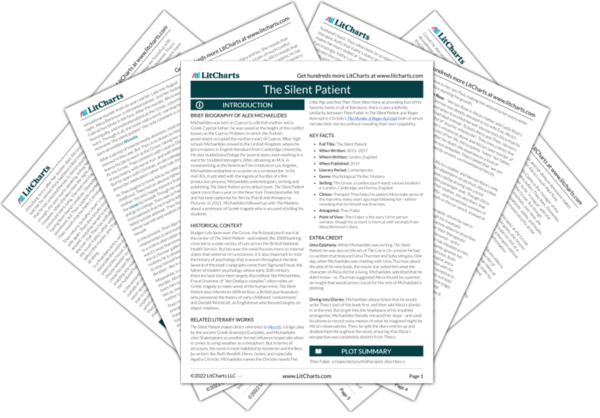Welcome to the LitCharts study guide on Alex Michaelides's The Silent Patient. Created by the original team behind SparkNotes, LitCharts are the world's best literature guides.
The Silent Patient: Introduction
The Silent Patient: Plot Summary
The Silent Patient: Detailed Summary & Analysis
The Silent Patient: Themes
The Silent Patient: Quotes
The Silent Patient: Characters
The Silent Patient: Symbols
The Silent Patient: Theme Wheel
Brief Biography of Alex Michaelides

Historical Context of The Silent Patient
Other Books Related to The Silent Patient
- Full Title: The Silent Patient
- When Written: 2013–2017
- Where Written: London, England
- When Published: 2019
- Literary Period: Contemporary
- Genre: Psychological Thriller, Mystery
- Setting: The Grove, a London psych ward; various locations in London, Cambridge, and Surrey, England
- Climax: Therapist Theo helps his patient Alicia make sense of the man who, many years ago, kept following her—before revealing that he himself was that man.
- Antagonist: Theo Faber
- Point of View: Theo Faber is the story’s first-person narrator, though his account is intercut with excerpts from Alicia Berenson’s diary.
Extra Credit for The Silent Patient
Uma Epiphany. While Michaelides was writing The Silent Patient, he was also on the set of The Con is On, a movie he had co-written that featured Uma Thurman and Sofia Vergara. One day, when Michaelides was chatting with Uma Thurman about the plot of his new book, the movie star asked him what the character of Alicia did for a living. Michaelides admitted that he didn’t know—so Thurman suggested Alicia should be a painter, an insight that would prove crucial for the rest of Michaelides’s plotting.
Diving into Diaries. Michaelides always knew that he would write Theo’s part of the book first, and then add Alicia’s diaries in at the end. But to get into the headspace of his troubled protagonist, Michaelides literally retraced her steps—and used his phone to record voice memos of what he imagined might be Alicia’s observations. Then, he split the diary entries up and divided them throughout the novel, ensuring that Alicia’s perspective was completely distinct from Theo’s.







